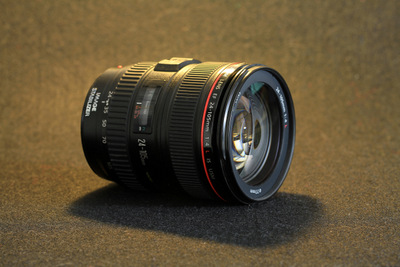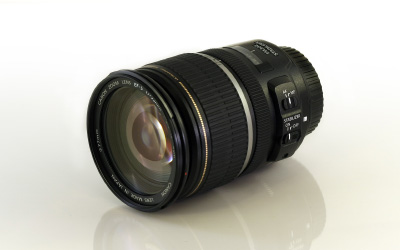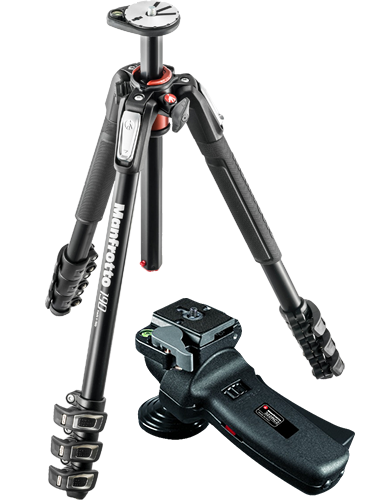Camera Body: Canon 7D Mark II

Canon EOS 7D Mark II
As a camera body, I use the Canon 7D Mark II, which has a 1.6 crop
factor, APS-C sensor, and a resolution of 20.2 megapixels. While its image quality and bokeh capability may
be slightly lower compared to full-frame cameras, I find the 1.6 crop factor very useful because it
multiplies the focal length of any lens I attach to this body by 1.6. This means that when I use my 400mm
lens, it effectively becomes a 640mm equivalent on a 35mm sensor. Another important aspect I consider when
choosing a camera body is how it feels in my hands and the quality it provides. The 7D Mark II's magnesium
alloy body is sturdy and comfortable to hold. It also excels in autofocus capabilities and allows shooting
at a fast 10 frames per second. With its dual DIGIC 6 processors, the camera operates swiftly. It also
features a built-in GPS receiver, which adds location coordinates to the EXIF data of each photo you take �
a crucial feature for travel photographers. However, since its initial release in November 2014, it has
gradually fallen behind its competitors due to its aging technology. Canon tried to compensate for this by
releasing firmware version 1.1.0 in September 2016, the most significant addition being the support for the
Canon W-E1 Wifi Adapter, which enables Wi-Fi connectivity for your camera. With the Canon Camera Connect app
on your mobile phone, you can now transfer photos from your 7D Mark II instantly to your smartphone and
share them on your social media accounts.
Main Use Lens: Canon EF 24-105mm f/4L IS USM
If I'm going anywhere, I'm probably using this lens. With its 5x optical
zoom capability (105/24), I don't need to change lenses frequently. Changing lenses can be a significant
time-waster and increases the risk of dropping the lens. Moreover, missing a great shot while changing
lenses can be a costly mistake. The 24-105 lens provides a versatile focal range on a 1.6 crop factor body,
equivalent to 38-168mm, making it quite useful. However, when you need a wider field of view, 38mm might
feel a bit narrow, so you'll also need a wide-angle lens in your bag. The lens's constant f/4 aperture,
while not extremely wide, is often sufficient. The fixed aperture of f/4 ensures worry-free shooting while
zooming. In low-light conditions, especially indoors, you might require a wider aperture or increased ISO
settings if your camera's performance allows. Lastly, it's worth mentioning that this lens boasts an
excellent image stabilizer (IS) that provides a 3-stop advantage. However, keep in mind that IS works to
eliminate your hand's vibrations, and it may not be effective if your subject is moving. In such cases, a
lower shutter speed and wider aperture are necessary.

Canon EF 24-105mm f/4L IS USM
Wide-Angle Lens: Canon EF-S 10-22mm f/3.5-4.5 USM

Canon EF-S 10-22mm f/3.5-4.5 USM
One of my favorite lenses... In the 24-105 section, I mentioned the need
for a wider-angle lens in your bag, and this is it. With its 10-22 focal range, it becomes an
ultra-wide-angle lens equivalent to 16-35 on APS-C bodies with a 1.6 crop factor. Since this lens is EF-S,
it cannot be mounted on full-frame bodies. Canon's EF lenses can be used on both full-frame and APS-C
bodies, while EF-S lenses can only be used on APS-C bodies. The lens provides a maximum aperture of f/3.5 at
10mm and f/4.5 at 22mm. However, this aperture variation is not a significant concern since wide-angle shots
typically require deep depth of field, and wider apertures are not commonly used. I usually shoot at f/7 or
narrower when using this lens.
Telephoto Lens: Canon EF 100-400mm f/4.5-5.6L IS USM
Perhaps my favorite lens of all. When you use it with the hood extended
to 400mm, people may mistake you for a photojournalist and clear your path. Unlike other lenses, this one
doesn't zoom by turning; it zooms in and out by extending and retracting. Its 100mm-400mm focal range
becomes exceptionally high on APS-C sensor bodies, equivalent to 160mm-640mm. You can even use a 1.4x or 2x
teleconverter for unbelievable 896mm or 1280mm focal lengths, but keep in mind that when you go below f/5.6,
the camera's autofocus feature won't work. With this lens, you can capture bird and wildlife photos without
disturbing them or shoot portraits from a distance. When shooting portraits up close, people often become
uncomfortable and lose their natural expressions. Another area where this lens shines is cityscape
photography. Due to their extremely narrow angles, you can capture unique shots that others can't. The
biggest drawback of this lens is its weight. Be prepared for backaches on long trips, especially those that
start in the morning and end in the evening. Mounting this lens on a tripod can also be challenging because
its weight distribution makes it difficult to balance. However, you can use the tripod collar that comes
with the lens to solve this issue.

Canon EF 100-400mm f/4.5-5.6L IS USM
My Macro Lens: Canon EF 100mm f/2.8L Macro IS USM

Canon EF 100mm f/2.8L Macro IS USM
This lens is one of the sharpest and highest-quality prime lenses Canon
has ever produced. While zoom lenses have adjustable focal lengths, fixed focal length lenses are called
"prime" lenses. This lens has a fixed 100mm focal length and a wide f/2.8 aperture. But more importantly, it
has the crucial hybrid IS (Image Stabilization) feature for macro photography. This feature helps in both
reducing vibrations and preventing minute forward and backward movements. The 100mm focal length allows you
to work at a sufficient distance from the objects you're photographing, which is crucial for macro lenses.
The level of magnification macro lenses provide is one of their most important features, and this lens
achieves 1:1 magnification. Although this lens is excellent in every aspect, I don't use it as much as my
other lenses because macro photography isn't my top priority.
My Portrait Lens: Canon EF 50mm f/1.4 USM
Perhaps the most important aspect of portrait photography is the ability
to isolate the subject from the rest of the photo. In other words, the person you're photographing should be
incredibly sharp and clear, while the background can be blurred (defocused). This way, distracting elements
in the background won't bother the viewer. The photography term for having a sharp foreground and a blurred
background is called "bokeh." To enhance this effect, you need very wide apertures because a wide aperture
reduces depth of field. However, when working with very wide apertures, you need to be careful because at
extreme values, the person's nose may be sharp, but their eyes might not be. This lens, with its wide f/1.4
aperture, excels at creating beautiful bokeh. Additionally, the f/1.4 aperture can capture a lot of light,
making it a lifesaver in low-light conditions. Canon offers three 50mm prime lenses at different price
points: the f/1.2 L, the f/1.4, and the f/1.8. The f/1.2 lens, with its approximately $1500 price tag,
caters to professionals, while the f/1.4 lens, which I also own, offers a good balance of price and
performance. The f/1.8 lens, despite its successful image quality, loses points for being made of plastic
material. However, it offers the best price-to-image quality ratio.

Canon EF 50mm f/1.4 USM
My Other General Purpose Lens: Canon EF-S 17-55 f/2.8 IS USM

Canon EF-S 17-55 f/2.8 IS USM
First, let me clarify that this lens is not mine, unfortunately; I borrow it from a friend from time to
time. This lens is on its way to becoming my recent favorite general-purpose lens. As you may know,
Canon appends the "L" designation to its professional lenses, signifying their use of higher-quality
optical materials and crowning them with the famous red ring (you can see the red ring in the photos of
L lenses above). However, this practice applies only to the EF series, which is suitable for full-frame
cameras. Strangely, they don't use the "L" category for crop sensor EF-S series lenses. But if this lens
were an EF lens, it would definitely deserve the "L" designation. It has a fixed f/2.8 aperture, highly
effective "IS," and a focal range equivalent to 27-88mm in 35mm terms. With these specs, it's comparable
to Canon's famous EF 24-70mm f/2.8L II USM lens, which costs around $2,300, and the 17-55mm lens even
has IS. When you combine f/2.8 and IS in low-light conditions, it produces impressive results. You can
take a look at one of my favorite photos taken in low-light conditions with this lens, the Hagia Sophia
photo, by clicking on this link. Without this lens, this
photo wouldn't exist.
My Tripod: Manfrotto 190XPROB, 322RC2 Joystick Head
Tripods are essential for taking photos in low-light conditions. Especially during the "blue hour,"
which refers to the half-hour before sunrise and the half-hour after sunset when the light is at its
most beautiful. However, during the blue hour, light is extremely limited, requiring exposures of at
least a few seconds. With such long exposures, it's impossible to take vibration-free photos by hand, so
we need to secure our camera on a tripod. When shooting on a tripod, it's important not to use the
shutter button on the camera to prevent vibrations. Instead, you can use a wired/wireless remote shutter
release or the camera's 2-second timer mode. A remote shutter release provides a more convenient
solution. The key features of tripods are the weight they can carry, their own weight, and the
maximum/minimum heights they can reach. The Manfrotto 190XPROB can carry up to 5 kg in weight while
weighing 1.8 kg itself. The tripod's weight is quite important; most photographers opt for lightweight
travel tripods instead of their main tripods during day-long trips. Quality camera bags have provisions
for attaching these lightweight tripods. The 190XPROB doesn't fall into this category; I only take it
with me when I go out for a few hours of photography. The build quality of the 190XPROB is excellent,
and it has a unique feature with a patented center column that can be positioned horizontally, allowing
for very low-angle shooting (as low as 8.5 cm) (click for an example photo here). Its maximum height is 146 cm. Another important
aspect of tripods is the type of head they use. Different types of heads are available for different
purposes. I use the Manfrotto 322RC2 joystick head. With this head, you can press the joystick to
position it at the desired angle and release it to lock it in place. I find it to be the fastest and
most practical solution. The head weighs approximately 635g. So, the total weight, including the tripod
body, is 2.5 kg.

Manfrotto 190XPROB
Manfrotto 322RC2 Joystick Head
My Travel Tripod: MeFOTO RoadTrip Titanium Travel Tripod

MeFOTO RoadTrip Titanium Travel Tripod
When you see a photo you like, you may sometimes think that you could take the same one. Perhaps you're
right, but capturing a good photo requires serious effort and dedication. Luck factor is certainly
important, but to seize that luck, you need to create opportunities. For sunrise photos, this includes
setting alarms in the dark hours, carrying kilograms of equipment on your back, going to potentially
risky places alone, and sacrificing the time you would spend with your family for photography. One of
the most exhausting aspects of this is the weight issue. In your bag, you need to carry multiple lenses,
the camera itself, chargers, filters, a remote shutter release, and as if all that weren't enough, your
tripod. Especially when you travel abroad and take photos, you have to carry this equipment with you
from the moment you leave the hotel in the morning until you return well past midnight. If you don't
take the tripod with you in the morning, you'll have to come back to the hotel to get it in the evening,
possibly meaning a significant loss of time, especially if it requires going back across the city. The
best thing is to take the tripod with you in the morning... This is where my MeFOTO RoadTrip tripod
comes to the rescue for situations like these. Although my Manfrotto tripod produces fantastic results,
it's not a suitable tripod to carry with you all day. My Manfrotto 190XPROB tripod, along with the
322RC2 head, weighs 2.5 kg, whereas the MeFOTO tripod is much lighter at only 1.6 kg. However, its
capabilities and capacity are, of course, not as good as the Manfrotto. It reaches a maximum height of
150 cm and has a minimum shooting distance of 40 cm from the ground. You need to be careful when using
it, especially if your camera and lens are heavy, and particularly when shooting in a vertical position,
there is a high probability of vibration. But for horizontal shots, it performs flawlessly.
- Last update date: 11-24-2023 01:57:49 PM

